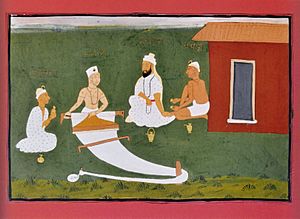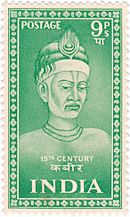Kabir facts for kids
Quick facts for kids
Kabir
|
|
|---|---|

Painting of Kabir weaving, c. 1825
|
|
| Born | 1398 |
| Died | 1518 (Aged - Approx. 120 years) Maghar, Lodhi dynasty
|
|
Main interests
|
|
|
Influences
|
|
|
Influenced
|
|
Kabir (1398–1518) was a famous poet and saint from India in the 15th century. He was known for his deep spiritual thoughts. His writings had a big impact on the Bhakti movement in Hinduism. His poems can also be found in the holy book of Sikhism, the Guru Granth Sahib. They are also in the Satguru Granth Sahib of Saint Garib Das and the Kabir Sagar.
Kabir was born in the city of Varanasi in what is now Uttar Pradesh. He was known for questioning organized religion. He believed that some religious practices were meaningless or wrong. He was brave enough to speak out against what he saw as problems in both Hindu and Muslim religions. Because of his strong views, he faced threats from both groups during his life. When he died, both Hindus and Muslims who admired him claimed him as their own.
Kabir taught that "Truth" is found in people who live right. He believed that everything, living or not, was divine. He also suggested that to find the Truth, one should let go of their "I" or ego. Kabir's ideas live on through the Kabir panth, a religious group that sees him as their founder. Its members are called Kabir panthis.
Contents
Kabir's Early Life
The exact years Kabir was born and died are not fully clear. Some historians think he lived from 1398 to 1448, while others believe it was from 1440 to 1518. Most people think Kabir was born in 1398. This was on a full moon day in the Jyeshtha month, according to the old Hindu calendar.
There are different stories about how Kabir was born. Many of his followers believe he came from a special place called Satloka. They say he appeared as a baby on a lotus flower in Lahartara Pond. A wise man named Ashtanand supposedly saw this happen.
Another story says that a Muslim weaver named Niru and his wife Nima found baby Kabir at Lahartara Lake. They raised him as their own child.
Kabir is widely believed to have become a student of Swami Ramananda. Ramananda was a Bhakti poet-saint in Varanasi. He taught that God was inside every person and everything. Early writings about Kabir's life connect him to both Hindu and Sufi (Islamic) traditions. Kabir's family is thought to have lived in the Kabir Chaura area of Varanasi. Today, there is a Kabīr maṭha (a kind of monastery) there that celebrates his life. Nearby is a house called Nīrūṭīlā, where Niru and Nima are buried.
Kabir's Poetry
Kabir's poems were written in everyday Hindi. He used words from different dialects like Braj, Bhojpuri, and Awadhi. His poems talked about many parts of life and encouraged a loving devotion to God. He used simple Hindi words in his verses. Most of his work focused on devotion, spiritual ideas, and self-discipline.
Kabir and his followers called his spoken poems "bāņīs" (utterances). These included songs and short poems called dohe, śalokā, or sākhī. The word sākhī means "witness," suggesting that the poems were proof of the Truth.
Some important books with Kabir's poems include Kabir Bijak, Kabir Parachai, Sakhi Granth, Adi Granth (Sikh holy book), and Kabir Granthawali. However, different versions of these texts exist. It's not always clear which one is the most original. Scholars like Charlotte Vaudeville have studied these different versions closely.
Kabir's poems were first spoken in the 15th century. They were passed down by word of mouth until the 17th century. Kabir Bijak was finally written down in the 17th century. Because the poems were passed down orally for so long, they changed over time. Sometimes, new songs or verses were added by unknown authors. This was often done out of respect for Kabir, not to trick anyone. Scholars have worked hard to figure out which poems truly came from Kabir.
Are All Poems Attributed to Kabir Authentic?
Many poems are said to be by Kabir, but experts now question if all of them are truly his.
Rabindranath Tagore translated and collected One Hundred Poems of Kabir in English, published in 1915. This book became very popular. However, scholars believe that only about six of these hundred poems are truly authentic. They also wonder if Tagore added his own ideas to Kabir's poems when he translated them in the early 1900s. Even if they are not Kabir's, these poems are still important to the Bhakti movement in India. They might have been written by people who admired Kabir later on.
Kabir's Philosophy and Beliefs
Some people today try to say that Kabir brought Hinduism and Islam together. But this isn't quite right. Kabir used ideas from different traditions, but he strongly declared his independence from both major religions. He criticized what he saw as foolish practices in both religions. He wanted his followers to have the same independent spirit. He used their words and ideas but also strongly criticized them. He even questioned the need for any holy book.
Many experts believe Kabir's ideas questioned the need for religion itself. He wasn't trying to create a new religion or unite Hindus and Muslims. Instead, he rejected the fake actions and wrong rituals he saw in religions of his time.
In his work Bijak, Kabir made fun of praying to avatars like Buddha. He said, "don't call the master Buddha, he didn't put down devils." Kabir encouraged people to look inside themselves. He wanted them to see all human beings as living forms of God.
Charlotte Vaudeville says that Kabir's philosophy was about finding the Absolute Truth. This Absolute is called nirguna. It's similar to the idea in the Upanishads that the soul inside a person (Atman) is the same as God (Brahman). This idea means there's no difference between a person's soul and God. It encourages people to see their true divine nature within themselves.
Kabir's Social Impact
Kabir's poems suggest that he was treated badly for his views while he was alive. For example, he said: "The slanderer is a friend, he cleanses the mind." He welcomed criticism. He called those who slandered him friends. He was thankful for the slander because it brought him closer to God.
Stories about Kabir often show him as an underdog who wins against powerful people. These stories appealed to the poor and those who felt oppressed. According to David Lorenzen, these stories show a "protest against social discrimination." They tell the story from the point of view of the poor and powerless. However, many scholars doubt if these stories of persecution are true. There isn't much proof, and it seems unlikely that a Muslim Sultan would take orders from Hindu Brahmins.
Kabir's Legacy
Kabir's writings were kept alive by two of his students, Bhāgodās and Dharmadās. Later, Kshitimohan Sen collected Kabir's songs from wandering holy people across India. These were then translated into English by Rabindranath Tagore.
New English translations of Kabir's songs have been done by Arvind Krishna Mehrotra. Many people say Mehrotra has captured the strong and free spirit of Kabir's poetry.
Kabir's legacy continues through the Kabir panth. This is a religious community that sees him as its founder. It is one of the Sant Mat groups. This community was formed centuries after Kabir died. Its members, called Kabir panthis, are estimated to be around 9.6 million people worldwide.
There are two temples dedicated to Kabir in Varanasi. One is looked after by Hindus, and the other by Muslims. Both temples have similar ways of worship. They sing Kabir's songs daily. They also have rituals like aarti (a prayer ritual) and distribute prasad (blessed food), similar to other Hindu temples. Followers of Kabir are vegetarians.
Kabir, Guru Nanak, and Sikhism
Kabir's poems were included in the Guru Granth Sahib, the holy book of Sikhism. His verses make up the largest part of the book that is not from Sikh gurus.
Some scholars believe Kabir's ideas influenced Guru Nanak, who founded Sikhism in the 15th century. Other Sikh scholars disagree. They say there are important differences between Kabir's and Nanak's views.
Harpreet Singh says that early Sikhism was part of the Hindu tradition. He believes Nanak was raised Hindu and belonged to the Sant tradition, which included Kabir. However, Surjit Singh Gandhi disagrees. He writes that Guru Nanak's ideas and actions were very different from Kabir's. So, he believes it is wrong to say Kabir influenced Guru Nanak.
Criticism of Kabir
Kabir has been criticized for how he described women. Nikky-Guninder Kaur Singh says, "Kabir's opinion of women is disrespectful." Wendy Doniger also thinks Kabir had a negative view of women. Schomer says that for Kabir, a woman was like "a black cobra" or "the pit of hell." According to Kabir, a woman could stop a man's spiritual journey.
However, other scholars have different interpretations. Dass suggests that in one poem, Kabir asks a married woman to stop covering her face. He believes Kabir was against certain social customs. Dass also adds that Kabir's poetry can be understood in two ways. One way is literally, where "woman" means a female human. The other way is symbolically, where "woman" stands for his own soul and "Rama" is the Lord-husband.
See also
 In Spanish: Kabir para niños
In Spanish: Kabir para niños




